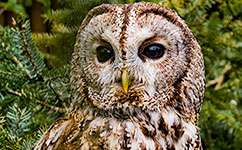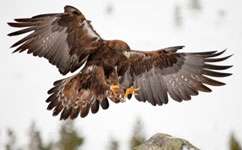Call to use raptors to monitor European pollution

Predatory birds like buzzards, eagles and barn owls could be used to monitor pollution across Europe, say scientists.
A network of regular surveys could measure the effectiveness of European regulations on pesticides and other chemicals, and give early warning of pollution problems across the continent, they say.
In recent years a number of studies have used the feathers, eggs and body tissues of raptors to reveal wider contamination of the environment.
Problems caused by lead shots used to kill game, and pollutants affecting the immune and reproductive systems, have all been detected in birds of prey.
'With a number of chemicals, their concentrations get higher as you go further up the food chain,' explains Professor Richard Shore – one of the study's authors – from NERC's Centre for Ecology & Hydrology.
'So in top predators like raptors, it is relatively easy to measure these contaminants, and it can tell you something about pollution of the ecosystem as a whole.'
'Most of the laws and regulatory decisions on pollutants are made at the European level, so it would make sense to monitor contamination at that scale as well.'
The team used a questionnaire to measure the scale of contaminant monitoring in birds of prey across 44 European countries.

According to the survey, there have been more than 50 such schemes throughout the continent over the past 50 years.
There are active schemes in 15 European countries, but most are in Western Europe. For a continent-wide monitoring system to work, Shore says they will need to spread eastwards.
'It may be that the samples are collected in the east, but are then analysed elsewhere,' he says. 'It's something that will need to be addressed.'
Insecticides, PCBs and metal contaminants were monitored in most countries, while fungicides, flame retardants and rodent poisons were also tracked fairly widely.
Raptor studies are particularly important in areas where game forms a substantial part of the human diet. Research on white-tailed sea eagles has highlighted the health risks of lead intoxication for both raptors and people in Sweden and Germany.
Last week, a study on a South Wales population of dippers revealed on-going pollution of the region's rivers by PCBs and flame retardant chemicals.
'The best species are those that are common and widely distributed,' says Shore. 'Buzzards, kestrels, eagles, peregrine falcons, barn owls and tawny owls are currently some of the most commonly monitored.'
The study is published in the journal Environment International.
More information: P. Gómez-Ramírez, R.F. Shore, N.W. van den Brink, B. van Hattum, J.O. Bustnes, G. Duke, C. Fritsch, A.J. García-Fernández, B.O. Helander, V. Jaspers, O. Krone, E. Martínez-López, R. Mateo, P. Movalli, C. Sonne, "An overview of existing raptor contaminant monitoring activities in Europe," Environment International, Volume 67, June 2014, Pages 12-21, ISSN 0160-4120, dx.doi.org/10.1016/j.envint.2014.02.004.
Journal information: Environment International
Provided by PlanetEarth Online
This story is republished courtesy of Planet Earth online, a free, companion website to the award-winning magazine Planet Earth published and funded by the Natural Environment Research Council (NERC).


















